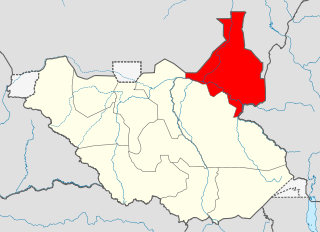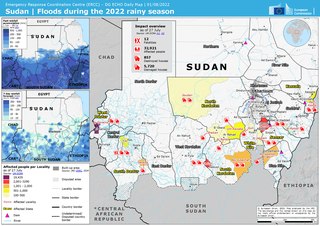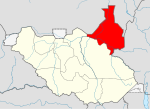
A refugee camp is a temporary settlement built to receive refugees and people in refugee-like situations. Refugee camps usually accommodate displaced people who have fled their home country, but camps are also made for internally displaced people. Usually, refugees seek asylum after they have escaped war in their home countries, but some camps also house environmental and economic migrants. Camps with over a hundred thousand people are common, but as of 2012, the average-sized camp housed around 11,400. They are usually built and run by a government, the United Nations, international organizations, or non-governmental organization. Unofficial refugee camps, such as Idomeni in Greece or the Calais jungle in France, are where refugees are largely left without the support of governments or international organizations.

Upper Nile is a state in South Sudan. The White Nile flowes through the state, giving it its name. The state also shares a similar name with the region of Greater Upper Nile, of which it was part along with the states of Unity and Jonglei. It had an area of 77,823 square kilometres (30,048 sq mi). Malakal was the capital of the state. The towns of Upper Nile State Benythieng Akoka, Maluth, Renk, Kodok, the location of the Fashoda Incident that ended the "Scramble for Africa", was located in the state. Upper Nile seceded from Sudan as part of the Republic of South Sudan on 9 July 2011.

Jonglei State is a state of South Sudan with Bor as its centre of government and the biggest city. Jonglei state comprises nine counties: Bor, Akobo, Ayod, Uror, Duk, Nyirol, Pigi, Twic East, and Fangak. Jonglei State is the largest state by area before reorganisation, with an area of approximately 122,581 km2, as well as the most populous according to the 2008 census conducted in present-day South Sudan's second period of autonomy. The boundaries of the state were again changed as a result of a peace agreement signed on 22 February 2020.

Kakuma is a town in northwestern Turkana County, Kenya. It is the site of a UNHCR refugee camp, established in 1992. The population of Kakuma town was 60,000 in 2014, having grown from around 8,000 in 1990. In 1991, the camp was established to host unaccompanied minors who had fled the war in Sudan, Somalia and from camps in Ethiopia. It was estimated that there were 12,000 "lost boys and girls" who had fled here via Egypt in 1990/91.

Dadaab is a semi-arid town in Garissa County, Kenya. It is the site of a UNHCR base hosting 302,805 registered refugees and asylum seekers in three camps as of 31 October 2023, making it one of the largest in the world behind Kutupalong refugee camp. The centre is run by the United Nations High Commissioner for Refugees, and its operations are financed by foreign donors. In 2013, UNHCR, the governments of Kenya and Somalia signed a tripartite agreement facilitating the repatriation of Somali refugees at the complex.

Bor is a historic city in South Sudan’s central region, being the epicenter of national liberation revolution with multiple landmarks that tells the story. In Malual-Chaat barrack, statues of liberators and destroyed weapons are conserved and exhibited at historical heritage site. It has also served as the headquarters of Jonglei state. The city is situated on the east side of the White Nile at the southern extent of the sudd, South Sudan's vast central wetlands.

Bentiu, also spelled Bantiu, is a city in South Sudan and capital of the state of Unity State.
Sudanese refugees are persons originating from the country of Sudan, but seeking refuge outside the borders of their native country. In recent history, Sudan has been the stage for prolonged conflicts and civil wars, as well as environmental changes, namely desertification. These forces have resulted not only in violence and famine but also the forced migration of large numbers of the Sudanese population, both inside and outside the country's borders. Given the expansive geographic territory of Sudan, and the regional and ethnic tensions and conflicts, much of the forced migration in Sudan has been internal. Yet, these populations are not immune to similar issues that typically accompany refugeedom, including economic hardship and providing themselves and their families with sustenance and basic needs. With the creation of a South Sudanese state, questions surrounding southern Sudanese IDPs may become questions of South Sudanese refugees.
By January 2011 the United Nations High Commissioner for Refugees (UNHCR) estimated that there are 262,900 Sudanese refugees in Chad. The majority of them left Sudan escaping from the violence of the ongoing Darfur crisis, which began in 2003. UNHCR has given the Sudanese refugees shelter in 12 different camps situated along the Chad–Sudan border. The most pressing issues UNHCR has to deal with in the refugee camps in Chad are related to insecurity in the camps,, malnutrition, access to water, HIV and AIDS, and education.
Melut County is an administrative area in Upper Nile State.
Nasir County is an administrative area in Upper Nile State, South Sudan. The headquarters is the town of Nasir, on the north side of the Sobat River, about 30 kilometres (19 mi) from the Ethiopian border.

Ger Duany is a South Sudanese and US-American movie actor and former refugee born in southern Sudan, who was resettled to the United States at the age of 15.
Doro is a village and a refugee camp in Maban County, Upper Nile State, South Sudan. It was previously a part of Upper Nile state.

Ulang is a county in Upper Nile State, South Sudan. The county border Nasir to the North and Akobo to the south. As in most other parts of South Sudan, Ulang lacks infrastructure. During decades of civil war, the countryside has been ravaged. Many people fled to refugee camps, and many failed to obtain an education. Skilled labor is in short supply. The economy is based on subsistence agriculture, with unpredictable yields. Over the last two years, Ulang has gained relative stability due to the new county commissioner's initiative, which focuses on reconciling various Ulang communities through reconciliation conferences.
Jamam was a refugee camp in Maban County, Upper Nile state, South Sudan.

Eastern Nile was a state in South Sudan that existed between 2 October 2015 and 14 January 2017 when it was divided into Central Upper Nile State and Northern Upper Nile State. It was located in the Greater Upper Nile region and it was part of the former states of Upper Nile and Jonglei. The state bordered the states of Eastern Bieh, Latjoor, Western Bieh, Fashoda State, and the country of Ethiopia to the east.
This article lists events from the year 2020 in South Sudan

In September 2020, profuse and continuous rainfall in Sudan caused a devastating flood across 17 out of the 18 states Sudanese states with the Blue Nile reaching water levels not seen for nearly a century. It ranks among the most severe floods recorded in the region. A state of emergency was declared, and teams have worked to prevent damage to threatened archaeological sites. The flood affected more than 3,000,000 people, destroyed more than 100,000 homes, and left more than 100 people dead.
Evan Atar Adaha is a South Sudanese surgeon who won the Nansen Refugee Award in 2018. Adaha left his physician's job in Egypt to provide healthcare in Sudan during the Second Sudanese Civil War. When violence forced him out of Sudan, he relocated to South Sudan and set up the only hospital in Upper Nile State that provides surgical capacity.

The 2022 Sudan floods saw the figure for flood-affected people in Sudan had exceeded the figure for 2021, rising to 314,500. From 2017 to 2021, there were 388,600 people affected by floods annually.













